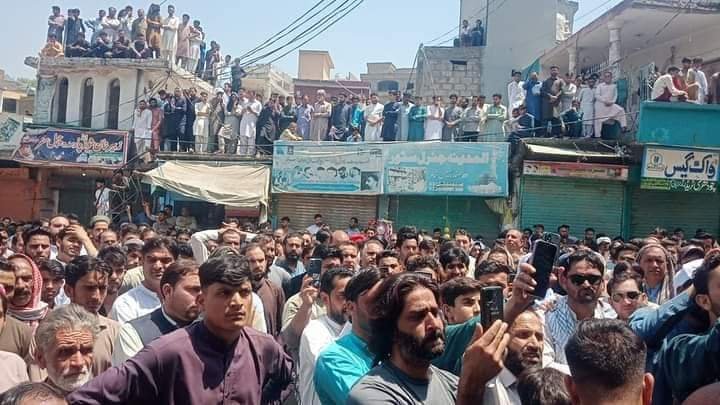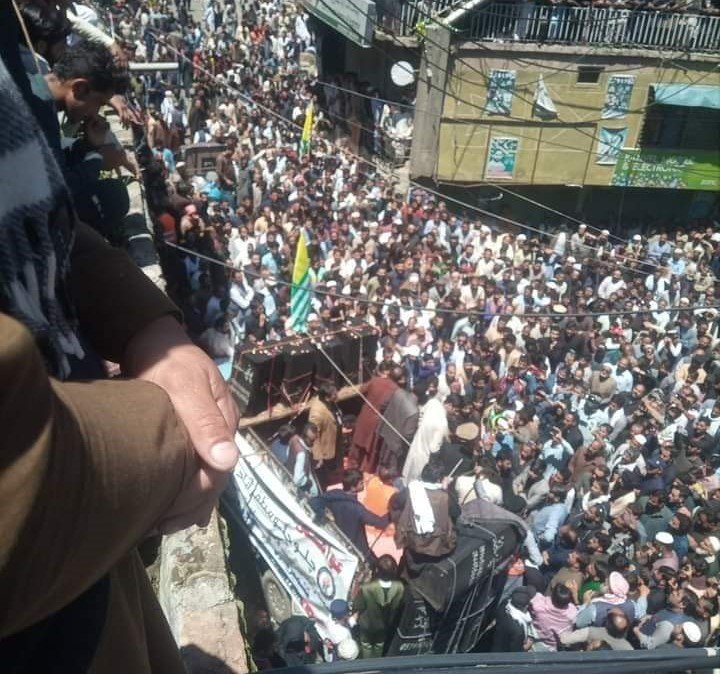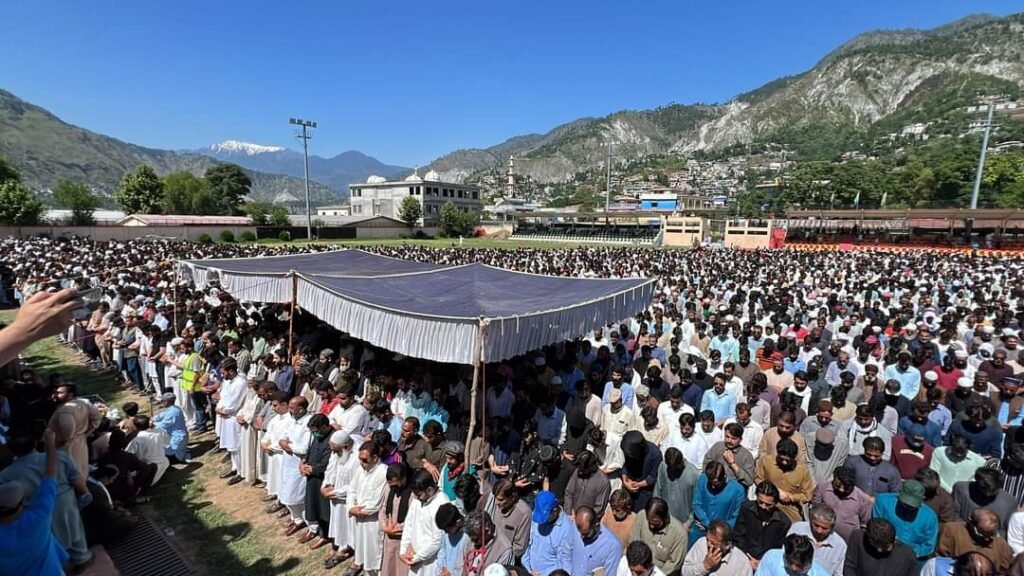In a historic display of unity and resilience, more than 500,000 people converged on Muzaffarabad, the capital of ‘Azad’ (‘Free’) Kashmir, on May 13, demanding lower prices for electricity and wheat flour. This unprecedented march, led by the Joint Awami Action Committee (AAC), succeeded in compelling the government to heed the masses’ calls for economic relief. The victory, hard-won after a year of persistent protests, reverberated across Pakistan and beyond, shaking the foundations of the political elite.
The pressure forced the government to announce reductions in electricity costs from Rs. 35 per unit to Rs. 6 for domestic users and Rs. 15 for commercial customers, alongside a decrease in the price of wheat flour. These concessions mark a significant achievement for the people of ‘Azad’ Kashmir, who have endured police repression, arrests, and even deaths in their struggle. The success underscores the power of mass mobilization and solidarity in challenging a system seen as indifferent to the basic needs of ordinary people.
Building a Movement Amid Repression and Hardship
The journey to this victory has been neither quick nor easy. Over the past year, the AAC has orchestrated eight major lockdowns, organized marches, and mobilized public defiance against electricity bill payments. Despite violent state repression, the movement continued to gather momentum. On May 11, the AAC called for a long march to Muzaffarabad, a decisive step that saw hundreds of thousands across ‘Azad’ Kashmir join the cause, including youth, families, and elders. In every village and town, residents came out in support, sharing food and water and raising their voices against government indifference.

The government’s response was brutal. Police forces, joined by reinforcements from neighboring provinces, tried to break the movement by blockading roads, using teargas, and arresting activists. In one incident in Dudyal, tear gas injured several young girls in a local school, igniting further outrage among protesters. These attacks only strengthened the resolve of the people, who continued their march despite the obstacles.
The AAC’s leadership proved pivotal in maintaining discipline and unity across the movement. As caravans from different districts converged on Poonch and Rawalakot, the people were greeted with solidarity, with hotels and homes offering free food and lodging. The AAC’s coordination turned the long march into a powerful demonstration of collective will, with participants overcoming roadblocks, weather, and repression to make their way to the capital.

The Role of Women: Backbone of the Resistance
While the main gathering in Muzaffarabad saw little female presence, women played a crucial role in the movement’s success. They organized food collections, managed logistics, and even confronted paramilitary forces attempting to infiltrate protest zones. In fact, the women-only protests organized by the AAC in October last year represented a turning point. Thousands of women, defying cultural restrictions, marched through the streets, voicing demands for economic justice and denouncing government oppression.
This protest marked the first time in ‘Azad’ Kashmir’s conservative society that women had taken to the streets in such numbers. Their participation energized the movement, breaking down societal barriers and reshaping community dynamics. This inclusion of women brought new vigor to the movement and led the government to take the AAC’s demands more seriously, culminating in the concessions won on May 13.

A Ripple Effect Across Pakistan
The victory in ‘Azad’ Kashmir has sent a wave of inspiration across Pakistan, where citizens are grappling with high inflation, unemployment, and rising energy costs. For many, the concessions secured by the AAC represent a model of grassroots power challenging an entrenched ruling class. Discussions of mass protests and further mobilization have taken hold, as people across Pakistan draw strength from the success in ‘Azad’ Kashmir.The movement’s impact on Pakistan’s political discourse is profound. Established political parties, including the PML(N), PPP, and PTI, have remained largely silent on the economic struggles of the working class. Yet the AAC’s victory has underscored the limitations of these parties and sparked calls for new leadership rooted in the struggles of ordinary citizens.
Facing the Ruling Class’s Countermeasures
The Pakistani government’s response to the movement in ‘Azad’ Kashmir was marked by familiar tactics: accusations that the protesters were agents of foreign interests, labeling the movement as dangerous and divisive. Similar tactics were used in India against farmers protesting Modi’s policies, framing them as aligned with Pakistan to undermine their legitimacy. Yet, the movement’s popularity made such accusations ineffective, as people saw through the ruling class’s attempts to discredit their fight for basic rights.
Attempts to incite violence and mischaracterize the movement were numerous. The Rangers, a paramilitary force, sought to enter Muzaffarabad, resulting in clashes with residents that left three protesters dead and several injured. These deaths further fueled the movement, with funeral services drawing thousands and amplifying calls for justice. The AAC has promised to continue seeking accountability for those killed and to maintain pressure on the ruling class to fulfill the movement’s remaining demands.
A Vision for the Future: Building People’s Power
The rise of the Awami Action Committees has been instrumental to this movement’s success, providing a grassroots alternative to the established political parties. These committees, rooted in local communities, organized boycotts, protests, and defense actions to protect residents from state repression. In the last year, the AAC has acted as an emerging structure of people’s power, facilitating the movement’s growth and ensuring that it remained independent of traditional party politics.
The success of these committees has demonstrated the potential for a new kind of political organization, one that empowers ordinary citizens rather than serving entrenched elites. For many, the AAC represents a glimpse of a future in which democratic organization can stand up to the excesses of capitalist governance and foreign influence, paving the way for a politics grounded in social justice and economic equity.
A Symbol of Defiance and Hope Across Borders
This victory in ‘Azad’ Kashmir resonates beyond Pakistan’s borders, as it encourages movements for economic and social justice throughout the region. In India, where the working class faces similar struggles under Modi’s government, the events in Muzaffarabad serve as a reminder of the power of unified resistance. The tactics used by ruling elites to silence dissent — nationalism, scapegoating, and repression — are familiar across South Asia, yet the movement in ‘Azad’ Kashmir has shown that these barriers can be overcome when people unite for common goals.
As the movement in ‘Azad’ Kashmir continues to push for change, it challenges both the Pakistani and Indian ruling classes, highlighting the potential of a people-driven movement to secure victories that go beyond temporary concessions. The AAC has shown that only through organized, independent action can the working class hope to secure lasting improvements in their lives.
This uprising has revitalized political debate in the region, moving beyond the divisive tactics of the past and reminding people of the power they hold when they come together. This moment represents not only a victory for ‘Azad’ Kashmir but a beacon of possibility for the oppressed across South Asia, with the potential to ignite future struggles for freedom, equality, and justice.

